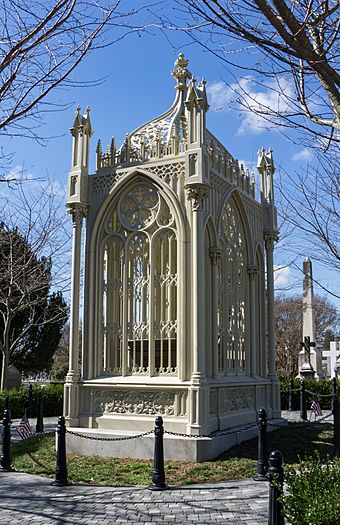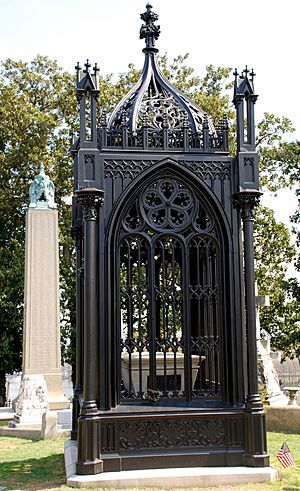James Monroe Tomb facts for kids
|
James Monroe Tomb
|
|
|
U.S. Historic district
Contributing property |
|
 |
|
| Location | Hollywood Cemetery, 412 S. Cherry St., Richmond, Virginia, U.S. |
|---|---|
| Built | 1858 |
| Architect | Albert Lybrock |
| Architectural style | Gothic Revival |
| Part of | Hollywood Cemetery (ID69000350) |
| NRHP reference No. | 71001044 |
Quick facts for kids Significant dates |
|
| Added to NRHP | November 11, 1971 |
| Designated NHL | November 11, 1971 |
| Designated CP | November 12, 1969 |
The James Monroe Tomb is where James Monroe, the fifth President of the United States, is buried. You can find it in Hollywood Cemetery in Richmond, Virginia, United States. The most interesting part of the tomb is its unique cast iron "cage." This cage was designed by Albert Lybrock and put in place in 1859. This happened after Monroe's body was moved from Marble Cemetery in New York City. Because of its special design, the tomb was named a National Historic Landmark in 1971. People in Richmond often call it The Birdcage because of how it looks.
Contents
What the Tomb Looks Like
The James Monroe Tomb is in the southern part of Hollywood Cemetery. It's in a noticeable spot, surrounded by a round road and looking out over the James River. James Monroe's body rests in a simple granite sarcophagus, which is like a stone coffin. This sarcophagus sits on a granite platform called a plinth.
The Unique Iron Cage
Around the sarcophagus is a fancy cast iron "cage." This cage is designed in the Gothic Revival style. It measures about 9 by 13 feet (about 2.7 by 4 meters). Each side of the cage has a pointed arch shape, similar to the designs you might see in large Gothic stained glass windows. At the top of each arch, there's a round pattern, like a rose window. On the longer sides, this main arch has smaller, narrow arches next to it. The corners of the cage have small columns called colonettes. These columns have small, shrine-like structures on top. The very top of the cage has curved parts that meet at a central spire, making it look like a tall, pointed roof. The grave of another president, John Tyler, is very close by.
History of the Tomb
James Monroe passed away in New York City in 1831. He was first buried in Marble Cemetery there. In 1856, Henry A. Wise, who was the Governor of Virginia, wanted to bring Monroe's remains back to his home state. Virginia provided money for this. Monroe's body was then brought to Richmond on a steamship called the Jamestown.
Design and Construction
The tomb was built in 1859. It was designed by a German-born architect named Albert Lybrock. The cast iron parts of the tomb were made by a company called Wood and Perot in Philadelphia. The tomb is very important for its architecture. It's special because of how much cast iron was used. At that time, cast iron wasn't usually used for such a big structure. Also, the design is very detailed and decorative. This kind of delicate and fancy look would have been impossible to create using only stone.
Recent Restoration Work
In 2015, there were plans to celebrate the 200th anniversary of James Monroe becoming president. As part of these plans, Monroe's tomb got a big update. The state of Virginia spent about US$900,000 on this project. Almost 40 percent of the tomb's cast iron structure was fixed. It was also painted a color that was closer to its original look. The restoration took almost a year to finish and was completed in September 2016.
See also
 In Spanish: Tumba de James Monroe para niños
In Spanish: Tumba de James Monroe para niños


